This authentic Chicken Rendang recipe brings you the flavors of Malaysian-Indonesian cuisine. Also known as Rendang Ayam, made with chicken slow-cooked to perfection in coconut milk with spices. It is traditionally served with Nasi Lemak (fragrant rice cooked in coconut milk), or paired with steamed rice or Naan. Here's how to make this flavorful Malaysian chicken rendang with step by step photos and a quick video recipe.
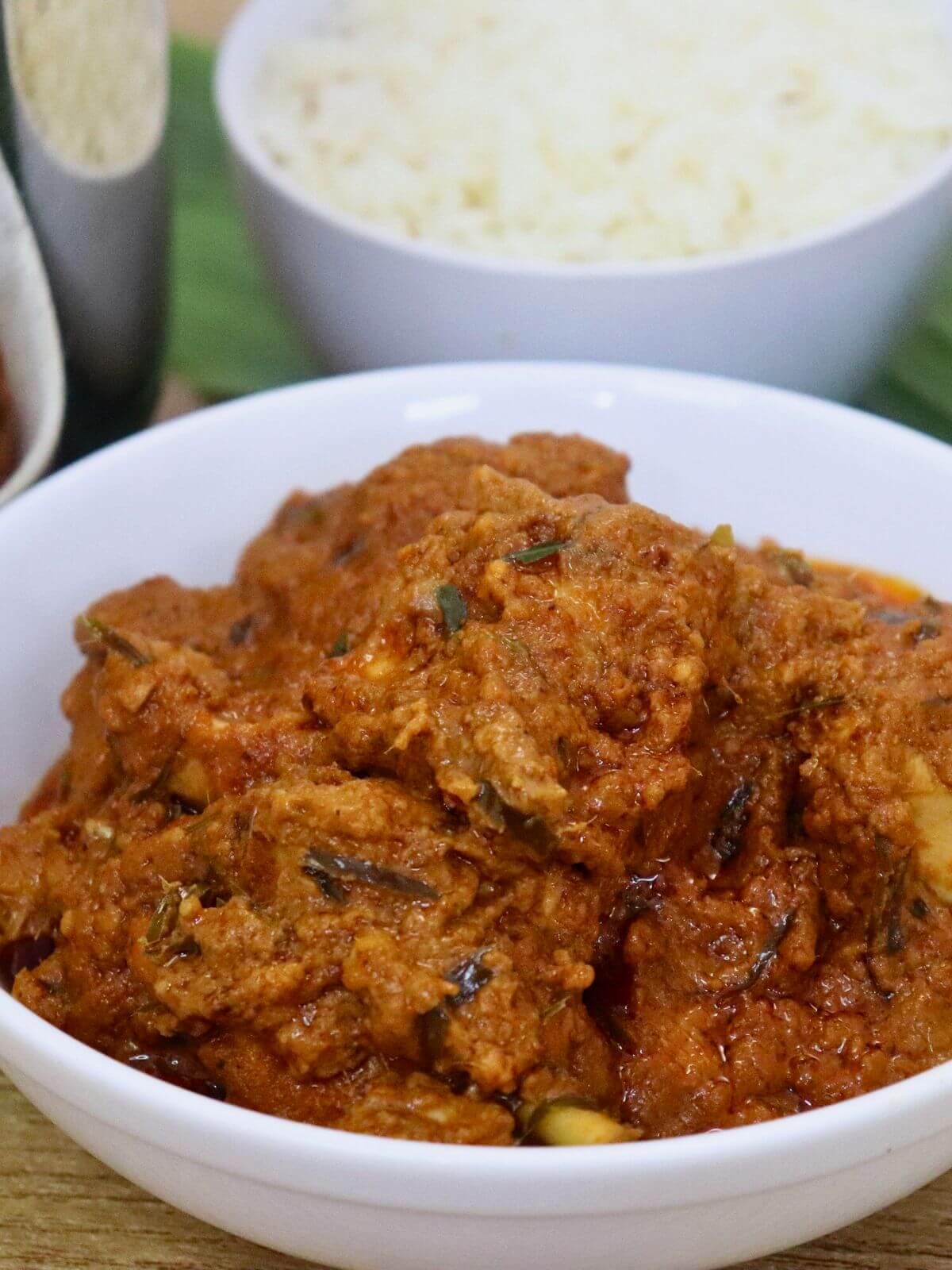
I tried chicken rendang during my trip to Malaysia a few years ago and posted the video on YouTube. Rendang Ayam is easy to make and the flavors are simply divine. The chicken is incredibly tender and slow-simmered in coconut milk and spices just like Ceylon Chicken. But rendang has a dry or semi-dry consistency like Chicken Ghee Roast or this Restaurant-Style Chicken Jalfrezi, where tender chicken pieces are coated in a flavorful and spicy rendang sauce.
Rendang is nominated by CNN as one of the best food in the world. The recent controversy on UK MasterChef, where a judge once criticized chicken rendang for not being “crispy,” sparked a wave of debate. But as any rendang fan knows, the meat, when simmered in coconut milk for long hours, cannot have crispy skin and also there isn’t enough sauce in this Malaysian chicken curry. This lively discussion reminded me just how much I love rendang and inspired me to share my favorite rendang chicken recipe with you.
About This Rendang Ayam Recipe
In this recipe post, I am sharing how to make Malaysian Chicken Rendang from scratch. I have covered all the details like prepping the ingredients, homemade spice paste, and how to make Kerisik for this rendang ayam recipe. "Ayam" is a word that is used both in Indonesian and Malay languages. It means "chicken".
Chicken Rendang or Rendang ayam, is a traditional Indonesian dish, that’s also popular in Malaysia and other Southeast Asian countries. Rendang is a spicy, flavorful, and aromatic curry made traditionally with beef, popularly called beef rendang. However, rendang ayam is a delicious and flavorful alternative made with chicken.
Making Rendang Chicken requires patience. The meat is slow-cooked in coconut milk with spices until tender and coated with thick rich gravy. Don't rush the cooking process; the longer it simmers, the better the flavor. Serve the rendang with rice, or use it as a filling for tacos, Mediterranena chicken wraps, or chicken mayo sandwiches. Rendang tastes incredibly delicious.
You may also like these other popular chicken recipes from this website:
Ingredients Notes
The foundation of a truly authentic rendang chicken is its spice paste. It is incredibly flavorful and aromatic and made with red chilies, shallots, turmeric, galangal, lemongrass, and garlic. The addition of turmeric leaves, kaffir lime leaves, and tamarind completes the rich and fragrant flavor profile of this delicious rendang giving it a unique and delightful taste. Here's what you will need to make this chicken rendang recipe.
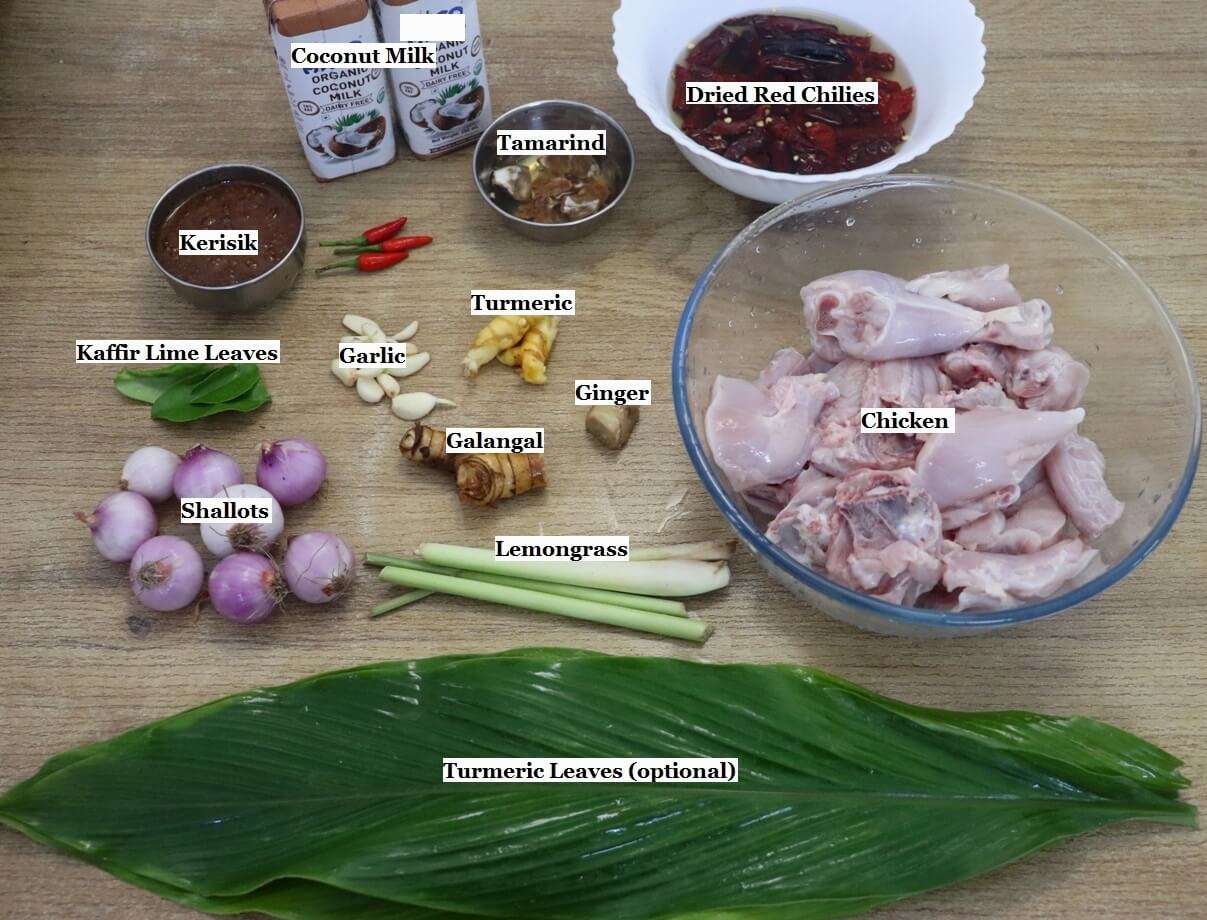
For the spice paste
- Red chilies: I used Kashmiri-dried red chilies for the rendang spice paste. I also added one spicy red chili for flavor. Add chilies as per your taste.
- Shallots: They are small onions used in many Asian curries. They add a subtle sweetness and depth to the curry. You can substitute them with 2 large onions.
- Galangal: Galangal is a ginger-like root with a citrusy flavor and a slight taste of pine. It gives the randang ayam a unique aroma.
- Turmeric: I used fresh turmeric. You can substitute it with ½ teaspoon turmeric powder.
- Ginger and Garlic: Commonly used in Asian cuisine.
- Lemongrass: This fragrant herb has a citrusy and slightly lemony flavor. It adds a refreshing aroma to the curry and helps cut through the coconut milk's richness.
For the chicken rendang recipe
- Oil: I used coconut oil. You can use any cocking oil with a high smoke point and neutral flavor.
- Whole Spices: I used green cardamoms, cinnamon, star anise, and cloves. They enhanced the aroma and flavor of rendang curry.
- Chicken (Curry Cut): I used whole chicken, curry cut. Bone-in chicken is the best choice for this recipe.
- Kaffir Lime Leaves: These leaves add a citrusy and fragrant aroma to the curry.
- Turmeric Leaf: Traditionally fresh turmeric leaves are used. Substitute them with Kaffir Lime Leaves.
- Coconut milk: This is the main ingredient in rendang, providing richness, creaminess, and a distinct coconut flavor.
- Jaggery: Add light sweetness to the curry. Substitute with sugar.
- Tamarind pulp: Provides a tangy and slightly sour taste, balancing the sweet and spicy flavor of the other ingredients.
- Kerisik: It is made from toasted coconut that's pounded, and adds a nutty and slightly smoky flavor to the curry. It also helps to thicken the sauce. You can use store-bought kerisik available at Asian grocery stores. I have shared the recipe to make it at home.
How to make Chicken Rendang Recipe with Step by Step Photos
Preparations
1) Soaking Red Chilies: To reduce their spiciness, deseed the red chilies. Cut them into halves or quarters. Soak dried red chilies in hot water for 15-30 minutes.
2) Soak tamarind: Soak tamarind in hot water for 15 minutes. Avoid adding excessive water; the water should be sufficient to immerse the tamarind. Now gently squeeze the tamarind to extract its pulp. If seeds are present in the tamarind, discard them.
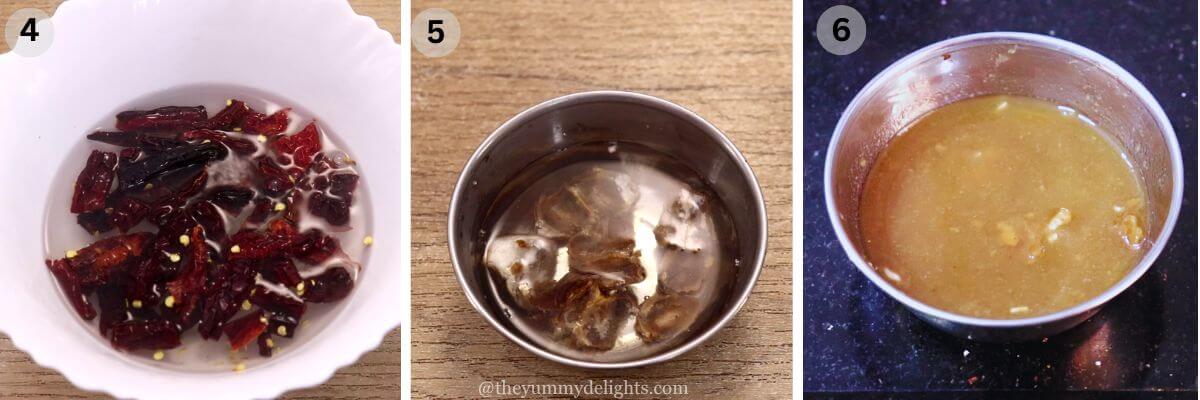
3) Chopping aromatics: Cut the turmeric and Kaffir lime leaves into thin strips. Quarter the shallots. Peel the galangal and ginger, then cut them into small pieces. Cut the lemongrass. (For a detailed visual guide, please watch the rendang video tutorial.)
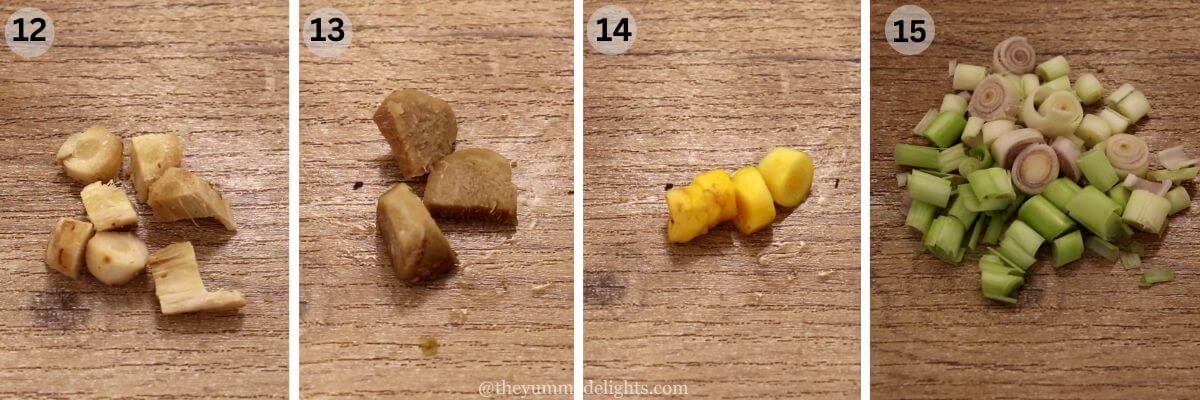
Making Kerisik
1) Roast the coconut: Place freshly scraped coconut in a deep bottom pan or pot. Roast over medium heat, stirring continuously to prevent burning. Once the coconut starts to turn golden brown, reduce the heat to low. Continue stirring until the coconut is evenly golden brown. Be very careful at this stage as coconut can burn quickly. Remove the roasted coconut to a plate while still warm (not hot).
2) Pound the coconut: Pound the roasted coconut in a mortar and pestle until it reaches a grainy texture and oil starts to release. Avoid using a mixer or blender as it will create an oily paste. Store the Kerisik in an airtight container in the refrigerator for future use. You can watch how to make Kerisik for more details.
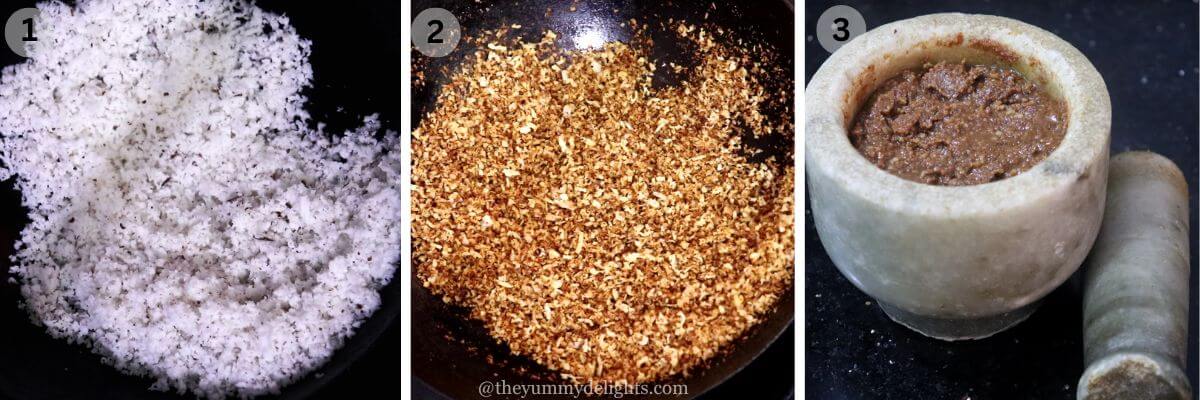
Making spice paste
1) In a mixer/blender jar, add soaked red chilies, spicy red chili (optional, for flavor), galangal, lemongrass, ginger, garlic, turmeric, and shallots. Add a little water and grind to a fine paste.
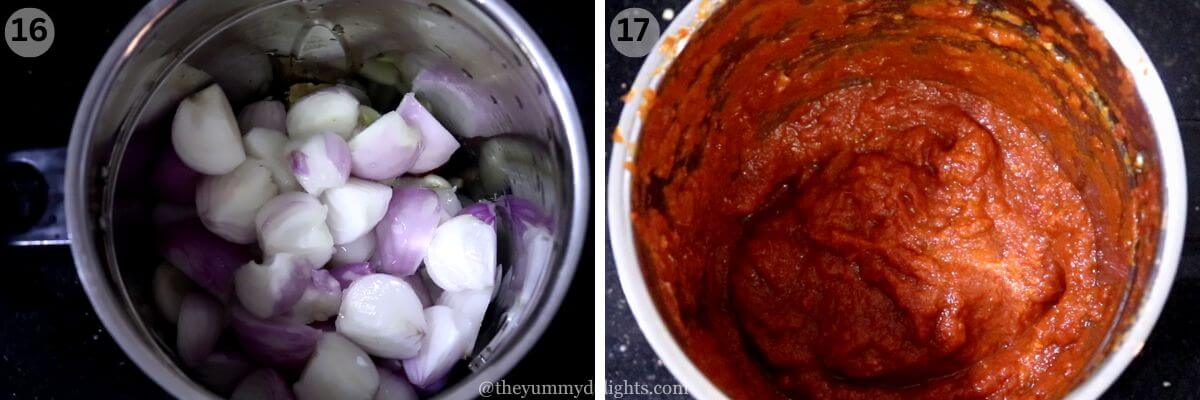
Making Malaysian Chicken Rendang
1) Heat ¼ cup of oil over medium heat. Add green cardamoms, cinnamon, cloves, and star anise. Sauté for a minute. Add the prepared spice paste.
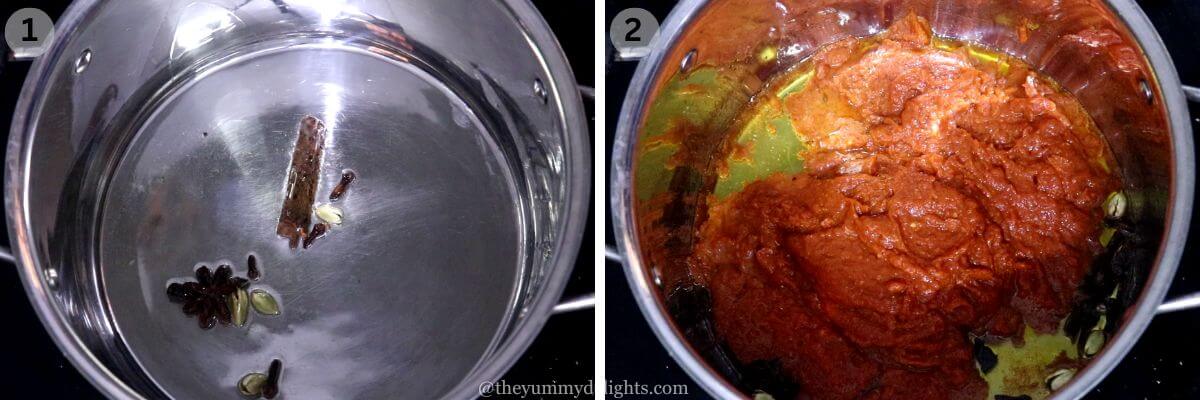
2) Cook until it begins to release oil from the sides. Stir continuously to prevent the spice paste from burning.
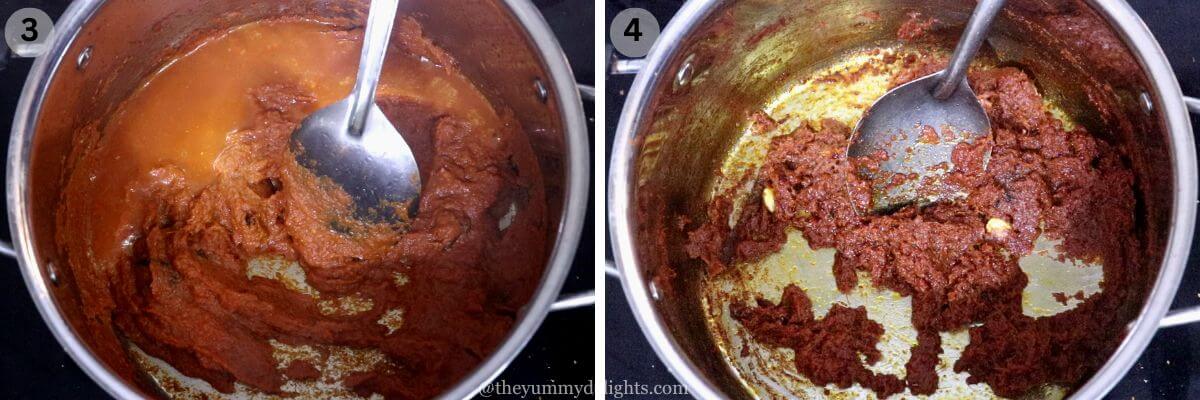
3) Add chicken. Stir to coat the chicken with the masala. Add salt. Stir fry and cook chicken for 5 minutes.
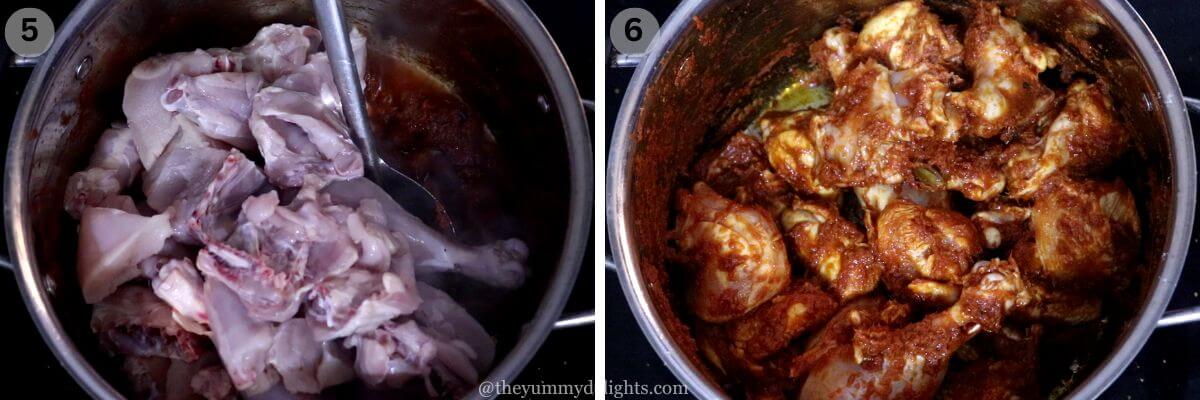
4) Add lemongrass stalk, turmeric leaves, and kaffir lime leaves. Sauté for a minute.
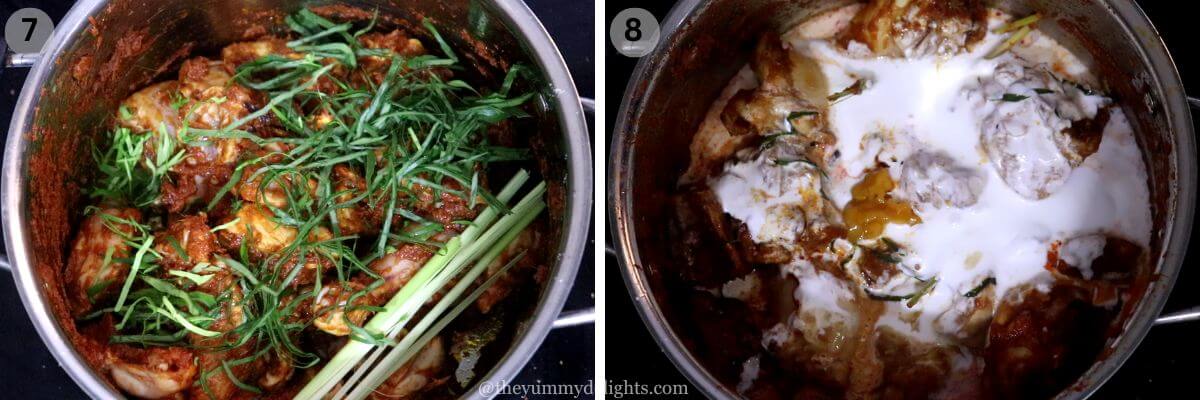
5) Add coconut milk, jaggery, tamarind pulp, and kerisik paste. Over medium-low heat, cover and cook until chicken is cooked.
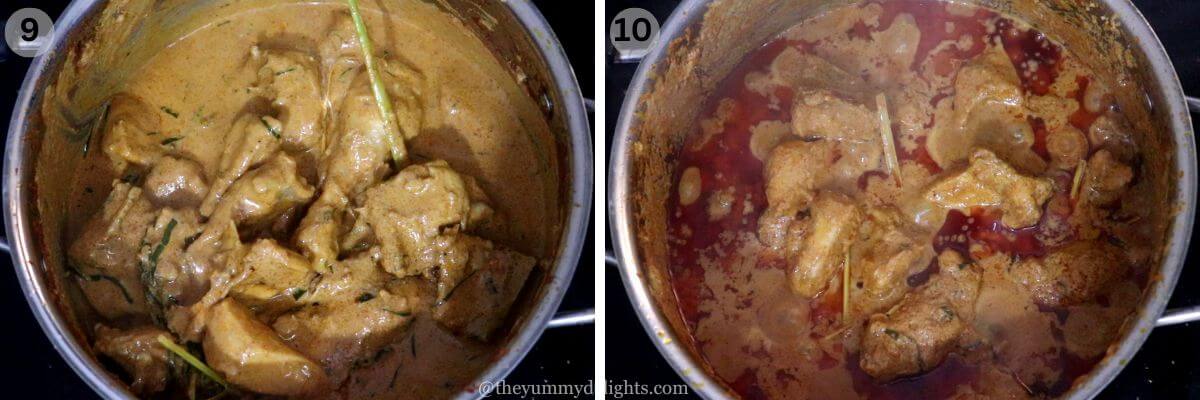
6) Remove the excess oil floating on the top.
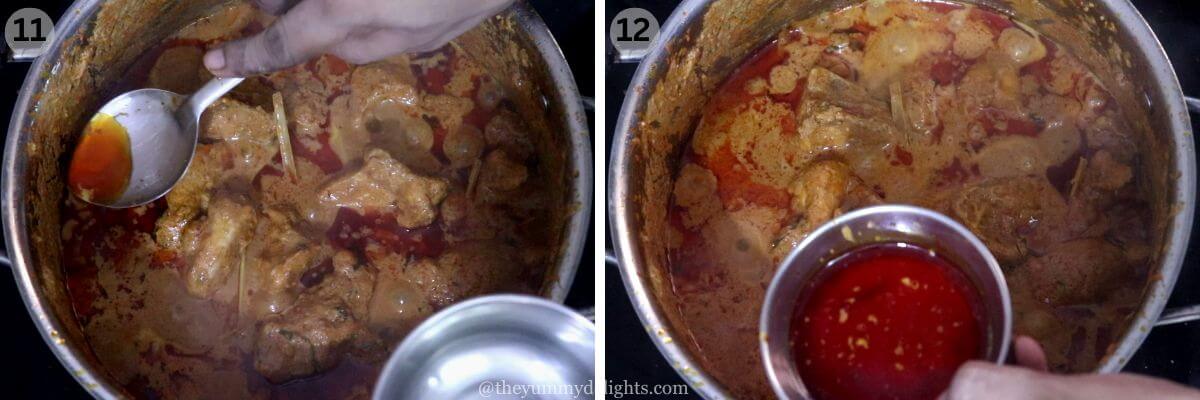
7) Taste and adjust the seasoning. Add more salt, sugar, or tamarind paste as per your taste. Cook uncovered for 5 minutes on low heat or until the excess moisture evaporates and the gravy thickens. I like to have a little curry so didn't cook it longer. Rendang Ayam is ready to serve. Serve this Malaysian rendang ayam with Nasi Lemak (fragrant rice cooked in coconut milk), or paired with steamed rice or Naan.
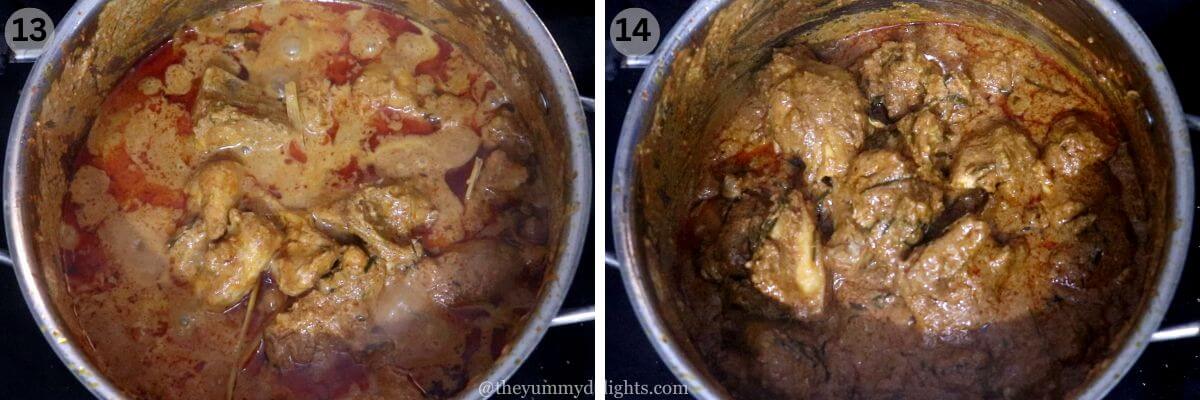
Tips to make the Best Chicken Rendang
- Coconut Milk: It is better to use full-fat coconut milk for a richer, creamier texture of rendang. Also, the chances of curdling the coconut milk are less while cooking rendang.
- Slow Cooking: Rendang chicken is a slow-cooked dish. Cook it on low heat. Allow ample time for the flavors to meld and the chicken to become tender.
- Simmering: Simmer the chicken in the coconut milk until the liquid has reduced significantly, leaving a thick, rich rendang sauce. This is a curry with less gravy/sauce.
- Stirring Frequently: Stir the mixture frequently to prevent sticking it to the bottom of the pan and ensure even cooking.
If you try this chicken rendang recipe, please leave a comment and rating below. We'd love to hear your feedback.
For any questions or concerns while making this recipe, please get in touch with me directly at nayakprety@gmail.com. I'll try my best to respond promptly.
And, consider following me on social media so we can stay connected. I’m on Facebook, Pinterest, and YouTube!
Related Recipes
Recipe Card
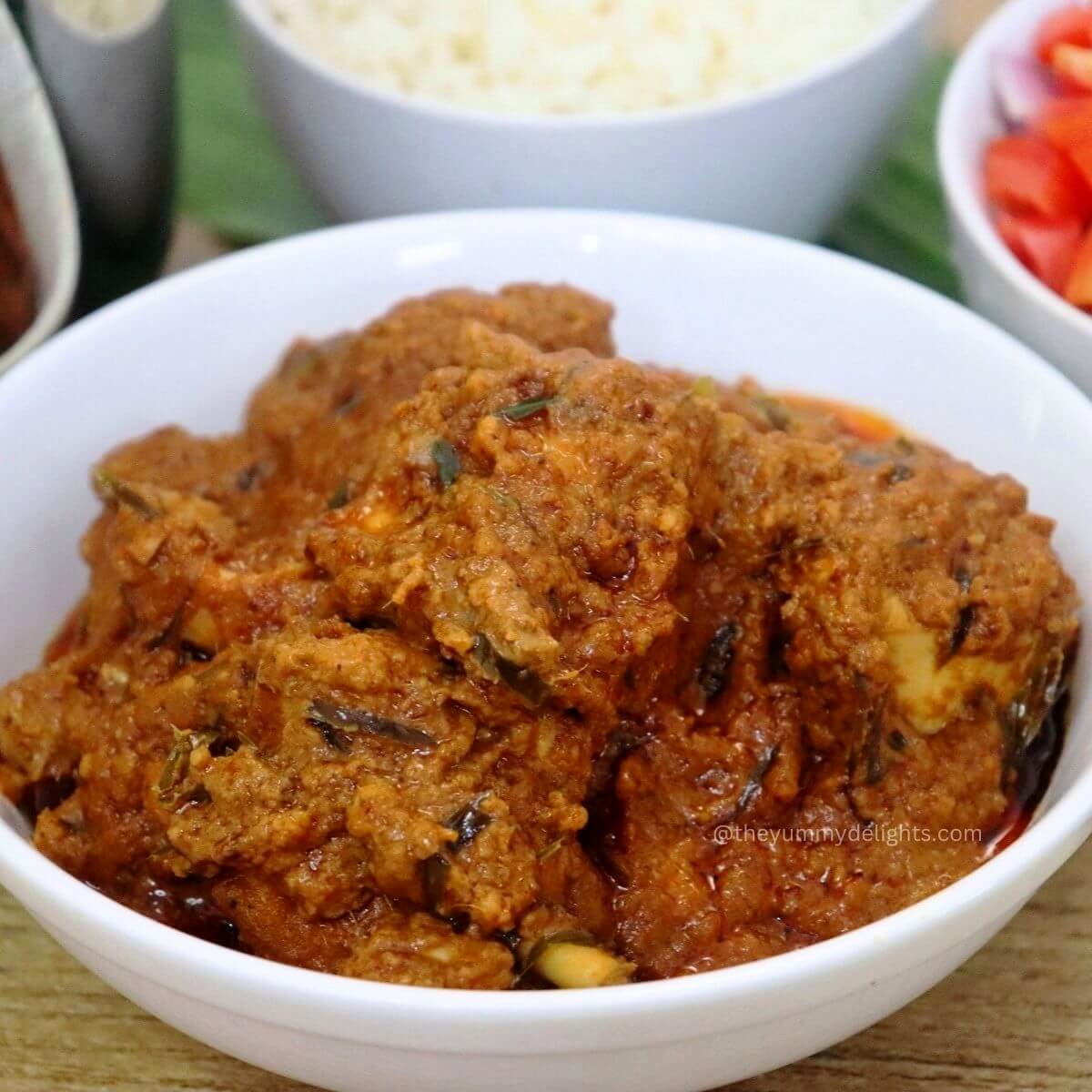
Authentic Chicken Rendang Recipe (Rendang Ayam)
Video

Equipment
- 1 heavy bottom pot/pan
- 1 Blender Jar
Ingredients
For Kerisik
- 2 cups of freshly scrapped/desiccated coconut
For the spice paste
- 12 dried red chilies I used Kashmiri red chilies
- 1 cup shallots. or 2 large onions
- 20 gm or 1-inch galangal
- A small piece of Turmeric ½ teaspoon turmeric powder
- 1- inch ginger
- 2 stalks of lemon grass
- Spicy red chilies optional, add as per taste
- 5-6 garlic cloves
For chicken rending
- ¼ cup of oil
- 4 green cardamoms slightly open them
- 1- inch cinnamon
- 1 star anise
- 4 cloves
- 1 kg chicken curry cut
- 1 teaspoon salt
- 5 Kaffir Lime Leaves
- 1 Turmeric Leaf traditionally used Substitute: Kaffir Lime Leaves
- 300 ml coconut milk
- 1 teaspoon jaggery
- 2 teaspoon Tamarind pulp 1 tablespoon tightly packed tamarind. Soak it in little hot water. Mash it in water to remove pulp.
- 2-3 tablespoon kerisik recipe given in this post
Instructions
Preparations for rendang ayam
- Soaking red chilies: To reduce their spiciness, deseed the red chilies. Cut them into halves or quarters. Soak dried red chilies in hot water for 15-30 minutes.
- Soak tamarind: Soak tamarind in hot water for 15 minutes. Avoid adding excessive water; the water should be sufficient to immerse the tamarind. Now gently squeeze the tamarind to extract its pulp. If seeds are present in the tamarind, discard them.
- Cut the turmeric and Kaffir lime leaves into thin strips. Quarter the shallots. Peel the galangal and ginger, then cut them into small pieces. Cut the lemongrass. (For a detailed visual guide, please watch the video tutorial.)
Making kerisik
- Roast the coconut: Place freshly scraped coconut in a deep bottom pan or pot. Roast over medium low heat, stirring continuously until golden brown. Immediately transfer roasted coconut to a plate.
- Pound the coconut: Pound the roasted coconut in a mortar and pestle until it reaches a grainy texture and the oil from coconut starts to release. It will take not more than 5-7 minutes. I tried using a mixer or blender but it create an oily paste. Store the Kerisik in an airtight container in the refrigerator for future use.
Making rendang spice paste
- In a mixer/blender jar, add soaked red chilies, spicy red chili (optional, for flavor), galangal, lemongrass, ginger, garlic, turmeric and shallots. Add a little water and grind to a fine paste.
Making Malaysian chicken rendang
- Heat ¼ cup of oil over medium heat. Add green cardamoms, cinnamon, cloves, and star anise. Sauté for a minute. Add the prepared spice paste. Cook until it begins to release oil from the sides. Stir continuously to prevent the spice paste from burning.
- Add chicken. Stir to coat the chicken with the masala. Add salt. Stir fry and cook chicken for 5 minutes.
- Add lemongrass stalk, turmeric leaves and kaffir lime leaves. Sauté for a minute.
- Add coconut milk, jaggery, tamarind pulp, and kerisik paste. Over medium low heat, cover and cook until chicken is cooked.
- Remove the excess oil floating on the top. Taste and adjust the seasoning. Add more salt, sugar or tamarind paste as per your taste. Cook uncovered for 5 minutes on low heat or until the excess moisture evaporates and the gravy is thick. Chicken Rendang is ready to serve.
Notes
-
- Coconut Milk: It is better to use full-fat coconut milk for a richer, creamier texture of rendang. Also, the chances of curdling the coconut milk are less while cooking.
- Slow Cooking: Rendang is a slow-cooked dish. Cook it on low heat. Allow ample time for the flavors to meld and the chicken to become tender.
- Simmering: Simmer the chicken in the coconut milk until the liquid has reduced significantly, leaving a thick, rich rendang sauce. This is a curry with less gravy/sauce.
- Stirring Frequently: Stir the mixture frequently to prevent sticking it to the bottom of the pan and ensure even cooking.
Nutrition
Nutrition information is automatically calculated, so should only be used as an approximation.

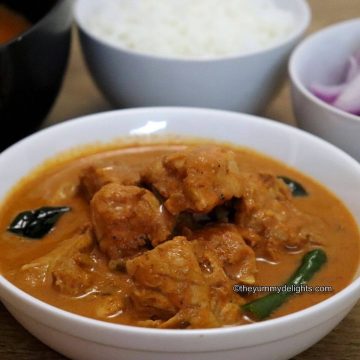
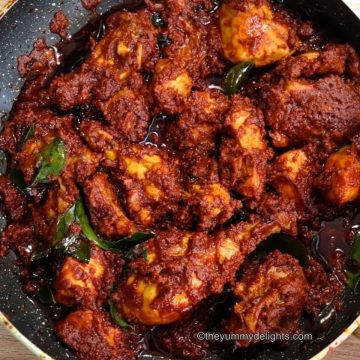
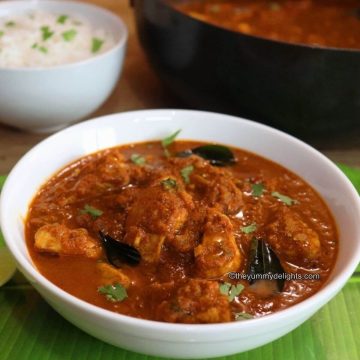
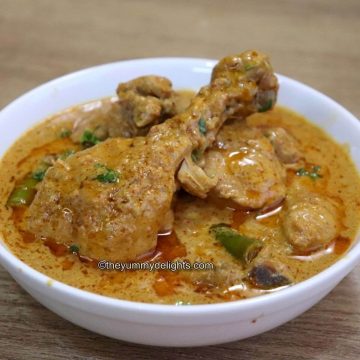
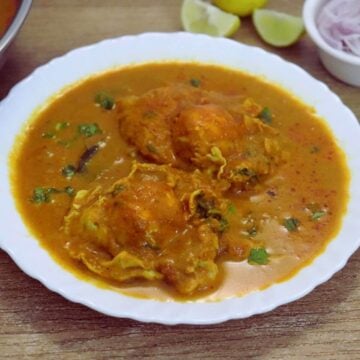



Preeti
This chicken rendang is packed with flavors. The tender chicken is simmered in a rich, aromatic blend of spices until it's melt-in-your-mouth, so delicious. You've got to try this one. It's a recipe you'll be making again and again.